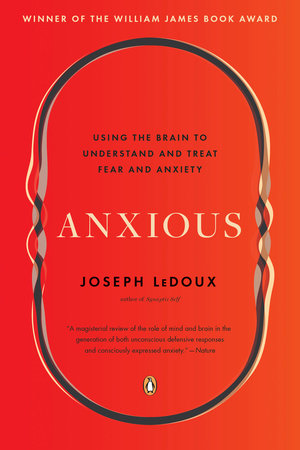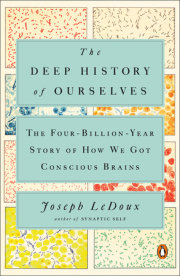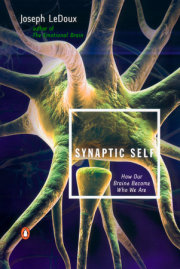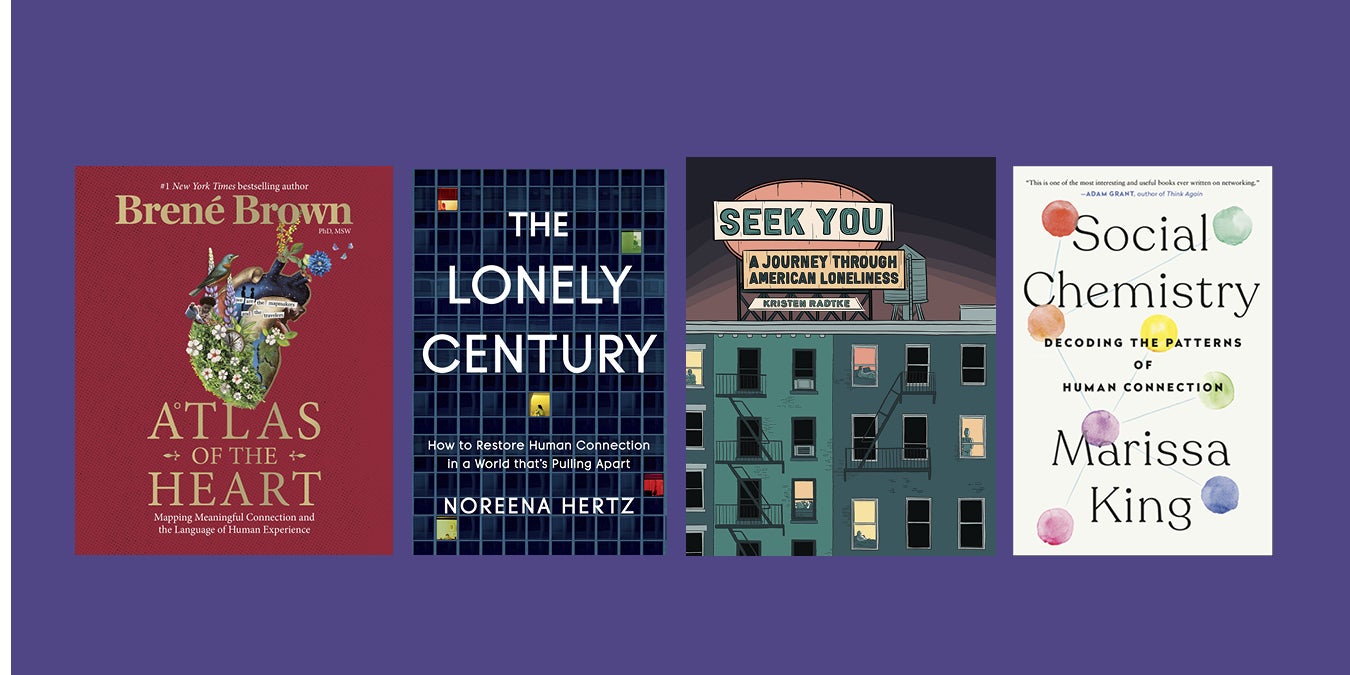PREFACE
When I completed my previous book, Synaptic Self, which was published in 2002, I wasn’t certain I wanted to write another book for a general audience. I had gotten the idea that the way to really have an impact on the field was to write a textbook in my particular area, behavioral and cognitive neuroscience. My agents, John Brockman and Katinka Matson, urged me not to, as did my editor at Viking, Rick Kot, each of them warning me that I would regret it as a publishing experience. After struggling with the project for almost a decade, I had to admit that they were correct. I discovered that the textbook format was far too restrictive—it had to be fresh and innovative . . . so long as it was just like every other competing book. After each chapter was reviewed by a number of teachers from a mix of universities, colleges, and junior colleges around the country, I began to feel little connection to the edited text that was resulting and concluded that my role was more to be a name on the cover than to actually drive the content.
A few years ago I ran into Rick at a reading by our friend Rosanne Cash, who wrote Composed under his editorship, and he asked with a wry smile, “How’s that textbook going? I’ve been waiting for you to bail out of that and do another book with me.” I was thrilled that he was still interested in working with me, and I negotiated, with some help from Eric Rayman, my way out of the textbook and prepared a new proposal for Katinka. Anxious was the result. Rick loved the idea, and so here we are.
Anxious is different from my other books. While The Emotional Brain and Synaptic Self can be thought of as a series of connected essays that hang together around a single theme, in Anxious each successive chapter builds on the previous ones to argue for a new view of emotion, especially the emotions fear and anxiety. Although the book is called Anxious, fear and anxiety are complexly entwined, and must be understood both separately and together.
As an overview, here are the key points that Anxious addresses. First, the science of emotion, and especially the science of fear and anxiety, now finds itself at an impasse, dictated by the way we discuss emotions in relation to the brain. For example, researchers use words like “fear” to describe the brain mechanisms that cause rats to freeze when in danger, and also to describe the conscious feeling that humans experience if they think that they will be seriously harmed physically or psychologically. The general idea is that a fear circuit in the brain is responsible for the feeling of fear, and when it is activated, whether in a rat or a human, the feeling of fear occurs, along with responses characteristic of fear (such as freezing, facial expressions, changes in body physiology). The feeling of fear is often said to mediate between the threatening event and those responses. Because these circuits are conserved throughout mammals, including humans, we can study human fear by measuring freezing in rats. The key circuits crucially involve the amygdala, which is generally described as the seat of fear in the brain.
In fact, most of what I have just described is wrong. Because my work and writings are in part responsible for these misconceptions, I feel some responsibility to try to straighten out the story before it goes further off track. One of the main goals of this book is to provide a new view of fear and anxiety, one that more accurately distinguishes what we can learn from animals from what we can best learn from humans, and what fear itself really refers to in the context of the human brain.
Don’t get me wrong: I am not arguing that we have to study brain mechanisms related to emotions exclusively in humans. There is much we have learned, and can continue to learn, and can, in fact, only learn, from animal research. But we do need a rigorous conceptual framework for understanding what the animal work does and does not mean for understanding the human brain. I offer my view of such a framework, which I think provides a new perspective on fear and anxiety, and the disorders related to these states.
The suggestions I make in this book concern in part the words we use to describe certain phenomena, but my argument is not simply about semantics. Words have extended meanings that imply a great deal. For example, some researchers who study fear in rats by measuring freezing behavior say that they are not studying what most people think of as fear, but rather some nonsubjective physiological state that they call fear. While this scientific redefinition of fear makes it more tractable as a research problem, it has three disadvantages. First, using fear in a nonconventional way to describe a physiological state that connects threats with responses often leads researchers to write and talk about this state as if it was referring to the conscious feeling of fear. Second, even when the researchers adhere to that definition, everyone thinks that they are actually studying the feeling of fear. And third, we in fact do need to understand the feeling of fear, and ignoring it is not the solution.
As scientists we have an obligation to be precise in how we describe our research. This is especially important when the work is being used to conceptualize human problems—in this case, fear and anxiety disorders—and develop treatments for them. But because conscious feelings of fear and anxiety arise from circuits in the brain that differ from the circuits that control the expression of defensive behaviors like freezing, and are likely vulnerable to different factors, they need to be understood separately. Certainly the circuits that control defense responses and give rise to feelings of fear interact, but this does not mean that they are the same.
Failure to make such distinctions accounts for poor outcomes of studies that have attempted to develop new pharmacological treatments for fear and anxiety in animals, as the studies assess the effects of drugs on behavioral responses but then expect the drugs to actually make people feel less fearful or anxious. We have long known that there is discordance in how treatments affect the way people feel when threatened as opposed to the behavioral and physiological responses they express in such situations.
One of the key issues to point out is that people can be shown pictures of threats in such a way that they are not conscious of the stimulus, and have no conscious feeling of fear. But their amygdala is activated by the threat, and bodily responses, such as changes in perspiration, heart rate, or pupil size occur, showing that the detection and response to threat is independent of conscious awareness. If we don’t need conscious experience to control responses to threats in humans we should be cautious about concluding that conscious states cause rats to respond to threats. I am not saying that rats or other animals lack consciousness. All I am saying is that we should not simply assume that because they may respond the way we do when threatened they feel what we do. The problem is that scientific studies of animal consciousness are not easily performed.
Implied above is that fear and anxiety are conscious feelings. As such, we need to understand consciousness in order to understand fear and anxiety. Several chapters of Anxious are devoted to giving a progress report on the current state of our understanding of consciousness in neuroscience, psychology, and philosophy (at least from my perspective). Included is the controversial topic of animal consciousness, which, as I just mentioned, is extremely difficult to study scientifically. I suggest guidelines about how we might be more scientific in our approach to this subject.
My view of consciousness dates back to my graduate work on split-brain patients, which I conducted with my mentor, Michael Gazzaniga, at SUNY Stony Brook. We concluded that one important role of consciousness is to make sense of our complex brains. Much of what our brain does, it achieves nonconsciously. Our conscious minds then construct an explanation of what we experience. In this sense, consciousness is a self-narrative built from bits and pieces of information we have direct conscious access to (perceptions and memories) and also from the observable or “monitorable” consequences of nonconscious processes. Emotions are, as some now say, cognitive or psychological constructions.
Finally, I discuss issues related to therapy. One key argument I make is that contrary to popular opinion, the behavioral procedure called extinction is not the main process at work in exposure therapy. Extinction plays a role, but exposure therapy actually involves many more mechanisms, and it is possible they actually interfere with the ability to extinguish. Another principle I challenge is that avoidance is always a bad thing for people with anxiety, for I believe that a form of proactive avoidance can be very useful. These and a number of other ideas for improving psychotherapy come directly from animal research. The key is to know what we can and can’t learn from animals, and to not conflate the two.
• • •
I have dedicated this book to the many graduate students, postdoctoral, and technical researchers in my lab over the years who have contributed to the work with which I have been credited, for they deserve as much credit as I, and in some cases more. In alphabetical order they are:
Prin Amorapanth, John Apergis-Schoute, Annemieke Apergis-Schoute, Jorge Armony, Elizabeth Bauer, Hugh Tad Blair, Fabio Bordi, Nesha Burghardt, David Bush, Christopher Cain, Vincent Campese, Fernando Canadas-Perez, Diana Cardona-Mena, William Chang, June-Seek Choi, Piera Cicchetti, M. Christine Clugnet, Keith Corodimas, Kiriana Cowansage, Catarina Cunha, Jacek Debiec, Lorenzo Diaz-Mataix, Neot Doron, Valerie Doyere, Sevil Durvaci, Jeffrey Erlich, Claudia Farb, Ann Fink, Rosemary Gonzaga, Yiran Gu, Nikita Gupta, Hiroki Hamanaka, Mian Hou, Koichi Isogawa, Jiro Iwata, Joshua Johansen, O. Luke Johnson, JoAnna Klein, Kevin LaBar, Raphael Lamprecht, Enrique Lanuza, Gabriel Lazaro-Munoz, Stephanie Lazzaro, XingFang Li, Tamas Madarasz, Raquel Martinez, Kate Melia, Marta Moita, Marie Monfils, Maria Morgan, Justin Moscarello, Jeff Muller, Karim Nader, Paco Olucha, Linnaea Ostroff, Elizabeth Phelps, Russell Philips, Joseph Pick, Gregory Quirk, Franchesa Ramirez, J. Christopher Repa, Sarina Rodrigues, Michael Rogan, Liz Romanski, Svetlana Rosis, Akira Sakaguchi, Glenn Schafe, Hillary Schiff, Daniela Schiller, Robert Sears, Torfi Sigurdsson, Francisco Sotres-Bayon, Peter Sparks, Ruth Stornetta, G. Elizabeth Stutzmann, Gregory Sullivan, Marc Weisskopf, Mattis Wigestrand, Ann Wilensky, Walter Woodson, Andrew Xagoraris. Also included are Elizabeth Phelps, my long-standing collaborator, and her team at NYU, as they have done human versions of our rodent studies and verified that our findings apply to people.
For assistance with the ancient roots of the modern word “anxiety,” I am grateful to my son, Milo LeDoux, who was trained in classics at the University of Oxford, and is now a student at the University of Virginia School of Law, and Peter Meineck, clinical associate professor of classics at NYU and founder of the Aquila Theatre. The cognitive therapist Stefan Hofmann of Boston University helped me tremendously by providing key papers for me to read to help me better understand cognitive therapy and its relation to extinction. Isaac Galatzer-Levy, a colleague from the NYU Langone Medical Center Department of Psychiatry, read several chapters and made helpful comments.
I am also grateful to my illustrator, Robert Lee, for his patience in working through my various incomplete and sometimes incoherent rough drafts of the art.
Special thanks to William Chang, my longtime assistant, who has suffered graciously through many writing projects, and without whom completion of this project would have been far more onerous a task.
I have been continuously funded by the National Institute of Mental Health since 1986, and much of the research discussed here was made possible by its support. Recently, I have also been supported by the National Institute of Drug Abuse. In the past I have also received funding from the National Science Foundation. I am grateful to Robert Kanter and Jennifer Brour for their support.
In 1989 I joined the faculty of Arts and Sciences at NYU, where I have been a member of the Center for Neural Science and Department of Psychology. In recent years I have received appointments in psychiatry and in child and adolescent psychiatry at NYU Langone Medical School. NYU has been a loyal and generous friend to me and my research.
In 1997, through a collaboration between NYU and New York State, I was appointed as director of the Emotional Brain Institute. This is a multisite program with laboratories at NYU and at the Nathan Kline Institute for Psychiatric Research. Through support of this program by NYU and New York State we hope to make new gains in understanding fear and anxiety. Some of the studies described in this book have been conducted in this context.
John Brockman, Katinka Matson, and everyone at Brockman Inc. are incredible agents. I am grateful for all they have done for me over the years, starting with The Emotional Brain.
At Viking, I can’t lavish enough praise on Rick Kot. He was the editor of Synaptic Self as well, and I hope of future books that may be lurking deep down in the synaptic recesses of my brain. Rick’s assistant, Diego Núñez, has been terrific in helping navigate the end-of-book steps. And Colin Weber deserves special credit for designing such a compelling jacket image—so compelling, in fact, that it led to discussions about whether it might be too “scary” for anxious people.
I want to express my love and thanks to my brilliant and beautiful wife, Nancy Princenthal. Nancy and I were engaged in major book projects at the same time, both headed toward publication in the spring/summer of 2015. In spite of special challenges that she faced in completing her biography of the late artist Agnes Martin, she was a friend, companion, critic, and editor when each role was needed.
• • •
How did the title Anxious finally come about? In 2009 my band, The Amygdaloids, released an album titled Theory of My Mind on the Knock Out Noise label, on which Rosanne Cash sang two songs with me. One of the pieces that we recorded that didn’t make it onto the album was called “Anxious.” I always liked the song, and had been thinking of releasing it separately. That’s when the idea that the book should be called Anxious hit me. And it didn’t take long to make the next mental leap: Why not release both Anxious the book and Anxious the CD simultaneously, since my songs are related to the themes in the book? Colin Weber generously agreed to allow me to use the book jacket art for the CD cover. Below you will see a barcode that can be scanned for a onetime free download of the songs on Anxious.
. All rights reserved. No part of this excerpt may be reproduced or reprinted without permission in writing from the publisher.





